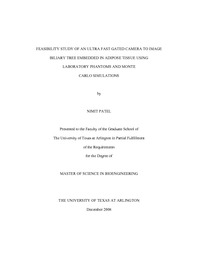
ATTENTION: The works hosted here are being migrated to a new repository that will consolidate resources, improve discoverability, and better show UTA's research impact on the global community. We will update authors as the migration progresses. Please see MavMatrix for more information.
Show simple item record
| dc.contributor.author | Patel, Nimit Lalitkumar | en_US |
| dc.date.accessioned | 2009-09-16T18:20:26Z | |
| dc.date.available | 2009-09-16T18:20:26Z | |
| dc.date.issued | 2009-09-16T18:20:26Z | |
| dc.date.submitted | January 2008 | en_US |
| dc.identifier.other | DISS-10125 | en_US |
| dc.identifier.uri | http://hdl.handle.net/10106/1862 | |
| dc.description.abstract | Every year, approximately 500,000 cholecystectomies are performed in US. As biliary tree structures are embedded in adipose tissue, they cannot be visualized directly by the surgeon, which causes inadvertent injuries to the common bile duct, vein and artery during a laparoscopic cholecystectomy. Thus there is an urge for an imaging modality which could see biliary tree structure through fatty tissue. Successful clinical implementation of an imaging system which could attain this goal would reduce surgical time, improve patient safety and minimize the risk of complications and expenses attributable to the current standard practice of intraoperative cholecystectomy. It is hoped that the work presented here will contribute to the accomplishment of this important clinical goal.I propose a novel time-gated imaging modality for the intraoperative localization of biliary tree structures by means of an ultra fast gated Intensified Charge Couple Device (ICCD) camera. I have done an exploratory study using Monte Carlo (MC) Simulations and laboratory phantom experiments. In the MC simulations the optical properties of bile and adipose tissue were used to mimic the actual clinical scenario. To check the effect of gate width on the performance of the camera, the MC simulations were repeated at two different gate widths (0.3 ns and 0.03 ns). To analyze sensitivity and spatial resolution of the proposed imaging technique, selected intensity profiles from the gated images/slices were fitted using a `Lorentzian Function'. Full Width at Half Maximum (FWHM) and Contrast to Background Ratio (CBR) of the fitted Lorentzian curve were used to characterize spatial resolution and sensitivity of the camera, respectively. The MC simulations were performed in both transmission and reflectance mode to find the suitable illumination geometry for the clinical measurements. Comparison was done for the CBR and FWHM values using both illumination schemes and two gate widths. In addition, results of the MC simulations were validated through laboratory phantom experiments with an absorber at different depths within an intralipid solution. The next step is to further test the imaging system in the laboratory using actual bile as an absorber in phantom experiments and then in the operation room. | en_US |
| dc.description.sponsorship | Liu, Hanli | en_US |
| dc.language.iso | EN | en_US |
| dc.publisher | Biomedical Engineering | en_US |
| dc.title | Feasibility Study Of An Ultra Fast Gated Camera To Image Biliary Tree Embedded In Adipose Tissue Using Laboratory Phantoms And Monte Carlo Simulations | en_US |
| dc.type | M.Engr. | en_US |
| dc.contributor.committeeChair | Liu, Hanli | en_US |
| dc.degree.department | Biomedical Engineering | en_US |
| dc.degree.discipline | Biomedical Engineering | en_US |
| dc.degree.grantor | University of Texas at Arlington | en_US |
| dc.degree.level | masters | en_US |
| dc.degree.name | M.Engr. | en_US |
| dc.identifier.externalLink | http://www.uta.edu/ra/real/editprofile.php?onlyview=1&pid=28 | |
| dc.identifier.externalLinkDescription | Link to Research Profiles | |
Files in this item
- Name:
- Patel_uta_2502M_10125.pdf
- Size:
- 1.931Mb
- Format:
- PDF
This item appears in the following Collection(s)
Show simple item record


